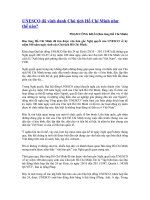LỜI BĂNG NGHE bài 3 , thi b1 châu âu trường ĐHSP Hồ Chí Minh
Bạn đang xem bản rút gọn của tài liệu. Xem và tải ngay bản đầy đủ của tài liệu tại đây (2.88 MB, 12 trang )
SCRIPTS 3
1.
2.
3
4
5.
6.
7.
8.
9-12
13-16
17-20.
Listen to a conversation between a professor and his assistant.
Dr Abercrombie: Good morning, Hanna. Thanks for coming in. How was your holiday?
Mr Fitch: It was very good, Professor, thanks. A week in the Appalachians is really
therapeutic. Nothing to do but eat, sleep, and listen to nature. It's beautiful up there in the spring- the countryside is so green-- and the people are so friendly and laid back. A good place to
unwind.
Dr: I envy you. I've just got too much to get done to get away at all now. I must get this
book finished, for one thing-- my publisher's getting impatient. I've outlined the last two
chapters, though, finally, so it won't take me too much longer, I hope. Maybe I'll be able to go
somewhere at Christmas. But, um, what I wanted to talk to you about is our syllabus for this
term, Hanna. I know this is short notice, but I'd like to make a couple of little changes to it.
Mr: Uh oh! I know your idea of "little" changes!
Dr: (laughs) No, no, I don't think it'll be that bad this time. What I'd like to do is, uh, cut
Lectures Two and Three-- the ones on Old English and Middle English-- down to half their
length and then meld them together into a single lecture. Then, with that extra ninety minutes, I
want to add a lecture at the end on World Englishes. I think it's time we dealt with that more
thoroughly, don't you?
Mr: Yessir, I certainly do. That's a good idea. So I guess I just need to cut down the
quizzes to match and add a new one for World Englishes. Do you know when I'll be able to see
your revised OE and ME notes?
Dr: I've already done a good bit of that revision, Hanna, and I think I'll have them ready
for you before Lecture One. That's April eighth, I think?
Mr. Yes, Tuesday the eighth.
Dr: I've taken the segments on pronunciation out-- I think we can lose those easily
enough. Nobody really needs to recite "Beowulf" or the "Canterbury Tales" any more-- no matter
how much fun it is.
Mr: And that means you probably won't be discussing orthography much either?
Dr: I suppose not. I just want to be sure to point out clearly the main ways in which
Modern English has developed from its predecessors. You know, the Great Vowel Shift, and so
forth. Saving ninety minutes is not going to commit Old and Middle English to total oblivion,
after all.
Mr: (laughs) Not if you can help it, certainly! So I can eliminate the phonetics quiz
completely, then?
Dr: Yes, I think so. I'll still give them a reading just so they can get a flavour of their
ancestral tongue, but they can get as much of the phonetics as they want out of the textbook-and it's rote learning anyway, really.
Mr: Now, what about your new lecture, then? Can I get started on any of that?
Dr: Yes, that's where I could really use your help in the next couple of weeks. I need you
to research 'pidgins and creoles' for me. I've never paid enough attention to them, and I'd like an
idea of the number there are, uh, their distribution, and uh, what linguists are saying about them
these days-- are they English dialects? Derivative languages? What? See if you can find me some
interesting examples and some specific quotes, will you?
Mr: Yes, of course. I think I know the kind of thing you're looking for. I'll take a look for
internet sources this afternoon and then see what the library has later.
Dr: Thank you, Hanna, I'd appreciate that. And while you're there, would you see if
they've got a copy of Burnley's source book on the history of English? I can't seem to find mine.
Mr: Oh. Uh... that's because you lent it to me last term... and erm, I haven't returned it yet.
Dr: Ah. Well. Get it back to me sometime soon, then, will you? I need to refer to it for
my revisions.
Mr: Yessir, of course. Anything else on the syllabus?
Dr: Just that we'll need the student handout revised to reflect the changes. Who was in
charge of that last time?
Mr: The department secretary has the file. I'll draft a revision, let you check it, and then
give it to her, shall I? Shouldn't take long, and we just need to get photocopies before the first
class.
Dr: All right, I'll leave that in your hands too then, Hanna. Just let me know if you need
anything. And I'll see you at the faculty meeting tomorrow afternoon.
Mr: Oh, yes. Yes. The faculty meeting. Oh, and if you need any anecdotes on
Appalachian English dialect, I'm your man-- I've just picked up a wealth of contemporary
examples!
Dr: (laughs) I'll keep that in mind. Thanks, Hanna.
21-25
26-30.
31-35
Listen to part of a lecture in social science class.
Prof: Today we're going to begin with a short quiz. No, no, you don't need pencil and
paper, just listen. It's only one question. Ready? OK. What do blogs, Pokemon, tattoos, Cabbage
Patch Kids, pet rocks, and hula hoops have in common? Anybody?
S1: They're all stupid. [laughter]
S2: I know, Professor Morgan. They're all fads.
Prof: Correct. Now here's another question: How did you know that? In other words,
what are the characteristics of a fad, and what's the difference between a fad and a trend? These
are the questions we're going to consider together this afternoon. Well, the main difference, I
think, between a fad and a trend concerns time. A fad is something that seems to appear
suddenly. It quickly becomes enormously popular, and then disappears just as suddenly as it
came. A trend also appears rather suddenly, and it also becomes very popular, but it doesn't
disappear. A trend can have a long-term influence on its particular market. Fads and trends often
resemble each other at first glance, but a fad usually has a definite beginning and end. Um,
Pokemon might be a fad, but the idea of fantasy playing cards for children might be a trend, for
example.
Another difference is that fads usually stay within one industry. Trends can cross over
into many industries. The hula hoop, for instance, has been called the greatest fad of all time.
Twenty five million [false start] In the late 1950s, 25 million hula hoops were sold in just four
months. But a year later, sales had virtually stopped. The hula hoop was a toy. It was fun to play
with, but that's about all. Now consider cell phones. They were designed to be portable
telephones, but they crossed over into the worlds of fashion, wireless communication, and now
even photography. People buy cell phones that match the latest clothes fashions. They use cell
phones for wireless Internet access. They take photos with them. Cell phones have become a
trend.
Ahem [clears throat or coughs] Here's a third difference between fads and trends: how
well industries accept them. Fads are often promoted by smaller companies. They need the quick
money that fads provide. Large companies don't accept fads right away. They can't afford to be
wrong. If someone [false start] If a company is known as a trend-setter, and it promotes a fad, its
reputation will be damaged. Large companies buy products in huge numbers. They don't want
unsold products sitting on their shelves. So they wait to see if a fad becomes a trend. Then they
will accept it in their stores. Now... yes?
S2: How long does a fad have to last before it becomes a trend? I mean, there are all these
energy drinks now. There used to be only a couple, but now there's like, a hundred. Are they still
a fad? Exercise is a trend, so wouldn't energy drinks be part of the exercise trend?
Prof: That's an excellent question! When exactly does a fad become a trend? You know,
there are people who are paid a lot of money to answer that question. If they get it right,
companies become rich and famous. If they get it wrong, companies go bankrupt and careers get
ruined. The short answer is: nobody knows. Distinguishing between fads and trends is an art, not
a science. If it were easy, there would be a lot more rich people in the world. Yes, in the back.
S1: Yeah, um...can't people get rich from fads, too? You said they sold 25 million hula
hoops in four months. Someone must have made big money off that?
Prof: Yes, they did. Toy companies made, uh, $45 million off of hula hoops by the time
the fad ended. And maybe some of you have heard of pet rocks, in the 1970s? A man bought a
rock for a penny, put it in a gift box and marketed it as a pet. He became an instant millionaire.
But the problem [false start] The trouble with fads is, no one can predict them. This man had no
idea that so many people would buy rocks as pets. He started it as kind of a joke. The Pokemon
creators had no clue their cards would become instantly popular all over the world. That's the
thing. Fads are mysterious to both their creators and to the public.









